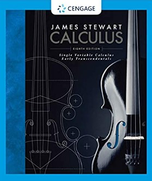Answer: When a foreign object lodged in the trachea (windpipe) forces a person to cough
Chapter 4, Problem 75(choose chapter or problem)
When a foreign object lodged in the trachea (windpipe) forces a person to cough, the diaphragm thrusts upward causing an increase in pressure in the lungs. This is accompanied by a contraction of the trachea, making a narrower channel for the expelled air to flow through. For a given amount of air to escape in a fixed time, it must move faster through the narrower channel than the wider one. The greater the velocity of the airstream, the greater the force on the foreign object. X rays show that the radius of the circular tracheal tube contracts to about two-thirds of its normal radius during a cough. According to a mathematical model of coughing, the velocity v of the airstream is related to the radius r of the trachea by the equation vsrd ksr0 2 rdr 2 1 2 r0 < r < r0 where k is a constant and r0 is the normal radius of the trachea. The restriction on r is due to the fact that the tracheal wall stiffens under pressure and a contraction greater than 1 2 r0 is prevented (otherwise the person would suffocate). (a) Determine the value of r in the interval f 1 2 r0, r0g at which v has an absolute maximum. How does this compare with experimental evidence? (b) What is the absolute maximum value of v on the interval? (c) Sketch the graph of v on the interval f0, r0 g.
Unfortunately, we don't have that question answered yet. But you can get it answered in just 5 hours by Logging in or Becoming a subscriber.
Becoming a subscriber
Or look for another answer
